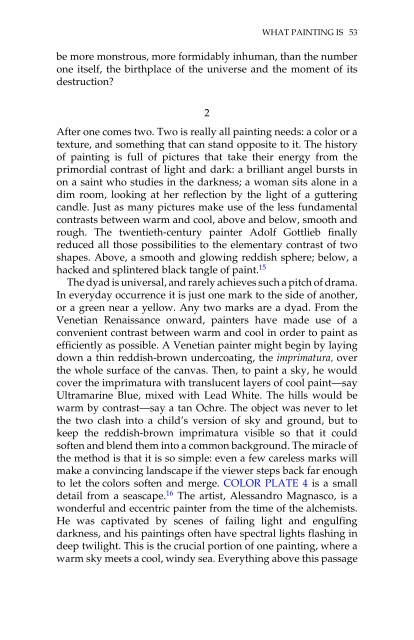What Painting Is: How to Think about Oil Painting ... - Victoria Vesna
What Painting Is: How to Think about Oil Painting ... - Victoria Vesna
What Painting Is: How to Think about Oil Painting ... - Victoria Vesna
Create successful ePaper yourself
Turn your PDF publications into a flip-book with our unique Google optimized e-Paper software.
WHAT PAINTING IS 53<br />
be more monstrous, more formidably inhuman, than the number<br />
one itself, the birthplace of the universe and the moment of its<br />
destruction?<br />
2<br />
After one comes two. Two is really all painting needs: a color or a<br />
texture, and something that can stand opposite <strong>to</strong> it. The his<strong>to</strong>ry<br />
of painting is full of pictures that take their energy from the<br />
primordial contrast of light and dark: a brilliant angel bursts in<br />
on a saint who studies in the darkness; a woman sits alone in a<br />
dim room, looking at her reflection by the light of a guttering<br />
candle. Just as many pictures make use of the less fundamental<br />
contrasts between warm and cool, above and below, smooth and<br />
rough. The twentieth-century painter Adolf Gottlieb finally<br />
reduced all those possibilities <strong>to</strong> the elementary contrast of two<br />
shapes. Above, a smooth and glowing reddish sphere; below, a<br />
hacked and splintered black tangle of paint. 15<br />
The dyad is universal, and rarely achieves such a pitch of drama.<br />
In everyday occurrence it is just one mark <strong>to</strong> the side of another,<br />
or a green near a yellow. Any two marks are a dyad. From the<br />
Venetian Renaissance onward, painters have made use of a<br />
convenient contrast between warm and cool in order <strong>to</strong> paint as<br />
efficiently as possible. A Venetian painter might begin by laying<br />
down a thin reddish-brown undercoating, the imprimatura, over<br />
the whole surface of the canvas. Then, <strong>to</strong> paint a sky, he would<br />
cover the imprimatura with translucent layers of cool paint—say<br />
Ultramarine Blue, mixed with Lead White. The hills would be<br />
warm by contrast—say a tan Ochre. The object was never <strong>to</strong> let<br />
the two clash in<strong>to</strong> a child’s version of sky and ground, but <strong>to</strong><br />
keep the reddish-brown imprimatura visible so that it could<br />
soften and blend them in<strong>to</strong> a common background. The miracle of<br />
the method is that it is so simple: even a few careless marks will<br />
make a convincing landscape if the viewer steps back far enough<br />
<strong>to</strong> let the colors soften and merge. COLOR PLATE 4 is a small<br />
detail from a seascape. 16 The artist, Alessandro Magnasco, is a<br />
wonderful and eccentric painter from the time of the alchemists.<br />
He was captivated by scenes of failing light and engulfing<br />
darkness, and his paintings often have spectral lights flashing in<br />
deep twilight. This is the crucial portion of one painting, where a<br />
warm sky meets a cool, windy sea. Everything above this passage


